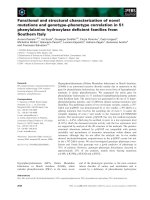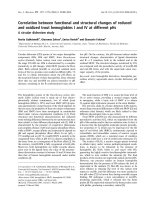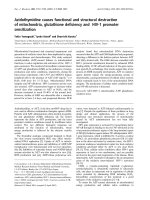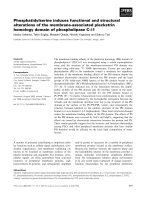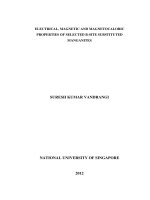Functional and structural properties of molecular soy protein fractions
Bạn đang xem bản rút gọn của tài liệu. Xem và tải ngay bản đầy đủ của tài liệu tại đây (1.77 MB, 170 trang )
FUNCTIONAL AND STRUCTURAL PROPERTIES OF
MOLECULAR SOY PROTEIN FRACTIONS
TAY SOK LI
(B.Sc. (HONS.), NUS)
A THESIS SUBMITTED
FOR THE DEGREE OF DOCTOR OF PHILOSOPHY
DEPARTMENT OF CHEMISTRY
NATIONAL UNIVERSITY OF SINGAPORE
2005
ACKNOWLEDGEMENTS
My deepest thanks go to my supervisor, A/P Stefan Kasapis for his guidance and
invaluable advice. His interest and encouragement had motivated me to excel and
made this research project very rewarding.
I would like express my gratitude and heartfelt thank you to my co-supervisor, A/P
Conrad O. Perera for his advice and teaching.
My special thanks go to my co-supervisor, A/P Philip J. Barlow for his constant
encouragement and always having a ready smile to offer.
I wish to thank A/P Xu Guo Qin, for his assistance in the usage of atomic force
microscopy and special thanks to Mr Darius Oh Hop Auk and Ms Dai Xue Ni for
their technical support in the operation of AFM. I would also like to thank Dr Yuan
Ze Liang for his technical support in the scanning electron microscopy. I must also
thank all the staff in the department of Chemistry and Food Science Technology
Programme for all the help.
Finally I am very grateful to all the people for making this project possible and
enjoyable.
TABLE OF CONTENTS
SUMMARY
LIST OF TABLES
LIST OF FIGURES
LIST OF ABBERVIATIONS
LIST OF PUBLICATIONS
LIST OF ABSTRACTS AND PRESENTATIONS
CHAPTER 1 Introduction
CHAPTER 2 The 7S and 11S proteins mixtures coagulated by
glucono-δ-lactone (GDL)
CHAPTER 3 The 7S and 11S proteins mixtures coagulated by
chloride or sulphate salt
CHAPTER 4 The effect of κ-carrageenan on the foaming,
gelling and isoflavone content of 11S
CHAPTER 5 The aggregation profile of 2S, 7S and 11S
coagulated by glucono-δ-lactone (GDL)
CHAPTER 6 The functional and structural properties of 2S soy
protein in relation to other molecular protein
fractions
CHAPTER 7 Conclusions and future studies
APPENDICES
I
III
IV
VII
VIII
IX
1
43
67
84
100
117
149
154
I
SUMMARY
Commercially available defatted soy flour was used in order to extract the three
major fractions of the protein (11S, 7S, and 2S). The functional and structural
properties of soy protein fractions were studied.
The gelling and aggregation behavior of the mixed protein systems of the two major
protein fractions with acid and salt coagulants were investigated. It was found that
mixtures of 11S:7S when reacted with glucono-δ-lactone (GDL) will produce
quantifiable gelation behavior based on the premise that higher levels of 7S in the
composite would require longer times of thermal treatment to achieve comparable
physicochemical properties. The mixtures of 11S:7S when reacted with salt
coagulants will result in different types of curd formation. Based on these differences,
the coagulating powers of various salts were determined and found to be in the order
of CaCl
2
> MgCl
2
> CaSO
4
> MgSO
4.
One of the ways to improve the nutritional and functional properties of soy protein
was the addition of hydrocolloid to the soy flour before the extraction of protein. It
was found that the addition of κ-carrageenan during the extraction of protein was
able to improve both the nutritional and functional properties. κ-Carrageenan when
added to soy flour during the extraction of 11S caused the 11S to have higher level
of isoflavone, better foaming properties and formed harder gels.
II
The functional and structural properties of 2S soy protein in relation to other
molecular protein fractions were investigated. 2S corresponds to the least percentage
composition in soy protein as compared with 7S and 11S. It was found that 2S
exhibits higher foaming and emulsification properties than 7S, and the latter faired
better than the 11S. We believe that this is due to 2S able to rapidly adsorb into the
air/water or oil/water interface and have higher surface hydrophobicity as compared
with the other soy fraction. The structural properties were monitored using texture
profile analysis (TPA), rheometer, scanning electron microscopy (SEM) and atomic
force microscopy (AFM). The size of the aggregates formed were in the order of 11S
>2S > 7S. This is due to the buffering capacity of 11S which is weaker than 7S thus
maintaining a lower value of pH in the solution (4.5), as opposed to 5.3 for 7S, and
reduced aggregation. It was found that the physical interactions were responsible for
aggregation process of 2S to be faster than 7S. Faster aggregation does not always
leads to harder gel. The large deformation, small deformation modulus and water
holding capacity (WHC) of the protein fractions gels were in the order of 11S > 7S >
2S. The ability to hold water in the 2S gel is the poorest due to the weaker gel
network formed as compared to the other two protein gels. Given time, 7S will
produce a firmer network with a better water holding capacity than that of 2S.
Physical interactions, as opposed to disulphide bridging, were found to be largely
responsible for the changing functionality of the 7S.
III
LIST OF TABLES
Table 1.1. Soy protein fractions
Table 1.2. Functional properties of soy protein (Kinsella, 1979)
Table 2.1. Hardness of soy gel heated for 60, 80 and 100 minutes
Table 2.2. Comparision of L*, hardness and pH of various ratio of 7S:11S
Table 3.1. Descriptions of the protein mixtures with coagulants
Table 3.2. Coagulation results of protein mixtures (4%, w/v) after addition of various
coagulants (0.008M)
Table 3.3. Physico chemical properties of protein mixture (4%, w/v) after coagulated
by calcium sulphate and magnesium sulphate
Table 4.1. Isoflavone Contents in 11S and 11S with κ-carrageenan
Table 4.2. Surface hydrophobicity of 11S and 11S + κ-carrageenan mixture
Table 4.3. The effect of carrageenan on gelling with various salt-coagulants
Table 4.4. Analysis results of “gel” mixtures with addition of carrageenan
Table 5.1. Average size of protein particles formed when 4 % protein solution heated
at 100
o
C for 10 minutes was deposited onto mica for 1, 2 and 4 minutes.
IV
LIST OF FIGURES
Figure 1.1. Chemical structure of aglycones
Figure 1.2. Chemical structures glucosides
Figure 1.3. Protein solubility profiles of soy protein isolate and soy protein
hydrolysate
Figure 1.4. The conversion of native protein into a protein network according to
heat-induced or cold gelation process
Figure 1.5. Schematic of the two type of network, (a) fine-stranded network; (b)
coarse network
Figure 1.6. The gelation mechanism of soy protein with glucono delta lactone (GDL)
or Ca
2+
Figure 1.7 Three types of disaccharides repeating sequence for carrageenans
Figure 2.1. SDS-PAGE of the soy protein fractions, lane (A) is 2S protein fraction;
lane (B) is 7S protein fraction; lane (C) is 11S protein fraction
Figure 2.2a. Comparison of hardness of soy gels heated for 20 and 40 min
Figure 2.2b. Comparison of hardness of soy gels heated for 60, 80 and 100 min
Figure 2.3. Comparison of gumminess of soy gels heated for 20, 40, 60, 80 and 100
min
Figure 2.4. Cohesiveness of soy gels heated for 20, 40, 60, 80 and 100 min
Figure 2.5. L* of soy gels heated for 20, 40, 60, 80 and 100 min
Figure 2.6 pH of soy gels heated for 20, 40, 60, 80 and 100 min
Figure 2.7. WHC of soy gels heated for 20, 40, 60, 80 and 100 min
V
Figure 2.8. Plot of various protein fractions against different lengths of heating time
Figure 3.1. Relationship of coagulating power and various state of curds
Figure 3.2. Turbidity of various slats with 11S protein
Figure 3.3. Turbidity of various slats with 7S protein
Figure 4.1. The chromatograms of the separation of the isoflavones of soy protein
Figure 4.2. Foaming properties of 11S with κ-carrageenan and 11S
Figure 5.1. Images of 11S protein (a) before the addition of GDL, (b-d) after addition
of 0.4% GDL: (b) 11S & GDL deposited onto mica for 1min. (c) 11S &
GDL deposited onto mica for 2 min (d) 11S & GDL deposited onto mica
for 4min
Figure 5.2. Images of 7S protein (a) before the addition of GDL, (b-d) after addition
of 0.4% GDL: (b) 7S & GDL deposited onto mica for 1min. (c) 7S &
GDL deposited onto mica for 2 min (d) 11S & GDL deposited onto mica
for 4min. Scan size: 3µm by 3µm
Figure 5.3. Images of 2S protein (a) before the addition of GDL, (b-d) after addition
of 0.4% GDL: (b) 2S & GDL deposited onto mica for 1min. (c) 2S &
GDL deposited onto mica for 2 min (d) 11S & GDL deposited onto mica
for 4min. Scan size: 3µm by 3µm
Figure 5.4. Turbidity measurement of 11S, 7S and 2S protein solutions
Figure 6.1. The interfacial behaviour of the three soy protein fractions, i.e., 11S, 7S
and 2S, as demonstrated for (a) the foaming and (b) the emulsifying
properties
VI
Figure 6.2. pH variation as a function of time following GDL addition at ambient
temperature for the three soy protein fractions.
Figure 6.3. Atomic force microscopy images of the three types of soy protein
aggregates: (a) 11S, (b) 7S, and (c) 2S following addition of 0.4% GDL
and deposition onto mica for 4 min
Figure 6.4. Absorbance readings at 600 nm due to the development of turbidity in the
three types of soy protein aggregates following GDL addition: (a) overall
profile, (b) in the presence of urea, and (c) in the presence of NEM
Figure 6.5. Electron microscopy images of the three types of soy protein gels: (a)
11S, (b) 7S, and (c) 2S
Figure 6.6. Absorbance readings at 600 nm due to the development of turbidity in the
three types of soy protein gels following GDL addition: (a) overall profile,
and (b) in the presence of urea
Figure 6.7. Time course of G' for the three soy fractions at 25°C, frequency of 1 rad/s,
and strain of 0.1%
VII
LIST OF ABBTRVIATIONS
A: Absorbance
AFM: Atomic force microscopy (AFM)
ANS: 1-anilino-8- naphthalene sulfonate (ANS)
BSA: Bovine serine albumin
FI: Fluorescence intensities
G’: Storage modulus
G”: Loss modulus
GDL: Glucono-δ-lactone
H
0
: Surface hydrophobicity
HPLC: High pressure liquid chromatography
Liq: Liquid
Mr: Molecular weight
NEM: N-ethylmaleimide
pI: Isoelectric point
Ppt: Precipitate
S: Svedberg units
SDS- PAGE: Sodium dodecylsulphate polyacrylamide gel electrophoresis
SEM: Scanning electron microscopy
UV: Ultra violet
WHC: Water-holding capacity
VIII
LIST OF PUBLICATIONS
1. Tay, S.L., Perera, C.O. Effects of glucono-δ-lactone on 7S, 11S proteins and
their protein mixture. Journal of Food Science. 2004, 69(4): FEP139-143.
2. Tay, S.L., Xu, G.Q., Perera, C.O. Aggregation profile of 11S, 7S and 2S
coagulated with GDL. Food Chemistry. 2005, 91, 457-462.
3. Tay, S.L., Tan, Han Yao, Perera, C.O. The coagulating effects of cations and
anions on soy protein. International Journal of Food Properties, in press.
4. Tay, S.L., Perera, C.O., Barlow, P.J. & Kasapis, S. 2006. Foaming,
emulsification and gelation properties of the molecular fractions of a soy
isolate. In Gums and Stabilisers for the Food Industry 13, eds. P.A. Williams &
G.O. Philips, The Royal Society of Chemistry, Cambridge, in press.
5. Sok Li Tay, Stefan Kasapis, Conrad O. Perera & Philip J. Barlow. Functional
and structural properties of 2S soy protein in relation to other molecular protein
fractions. (Submitted)
IX
LIST OF ABSTRACTS AND PRESENTATIONS
1. Singapore International Chemical Conference – 3 (SICC-3). “Frontiers in
Physical and Analytical Chemistry”. 15-17 December 2003. National
University of Singapore, and the Singapore National Institute of Chemistry
(SNIC), Singapore.
Poster presentation: Soy proteins – A study of aggregation process.
2. Regional Conference for Young Chemists 2004 (RCYC 2004). 13-14 April
2004. Universiti Sains Malaysia. Penang, Malaysia.
Oral presentation: The coagulating effects of cations and anions of coagulants
on 7S and 11S protein fractions.
3. Health Science Authority – National University of Singapore (HAS – NUS)
Scientific Seminar. “Health Through Scientific Research”. 19 May 2004.
Health Science Authority and National University of Singapore, Singapore
Oral presentation: Functional Properties of Soy Protein Fractions.
4. Institute of Food Technologists (IFT) Annual Meeting + Food Expo
®
.12-16
July 2004. Institute of Food Technologists. Las Vegas, Nevada, USA.
Oral presentation: Soy protein - Aggregation and gelation;
X
5. Institute of Food Technologists (IFT) Annual Meeting + Food Expo
®
.12-16
July 2004. Institute of Food Technologists. Las Vegas, Nevada, USA.
Poster presentation: Effect of extraction and UHT treatment conditions on
isoflavones and protein-quality during soymilk manufacture.
6. Gums and Stabilizers for the food industry. 20-24 June 2005. The Food
Hydrocolloid Trust. The North East Wales Institute. Wrexham, United
Kingdom.
Oral presentation: Foaming, emulsifying and gelation properties of the
molecular fractions of soy fractions.
1
Chapter 1
Introduction
2
1.1 SOY
The soybean belongs to the family Leguminosae and the genus name is Glycine L.
(Clarke and Wiseman, 2000a). It is the source of inexpensive and high quality
protein. Soybeans have long been a staple of the human diet in Asia, especially as
soymilk or tofu (Poysa and Woodrow, 2002). The consumption of soy based
products is increasing in North America due to an increase in Asian immigrants and
an increase in the recognition of the health benefits that this food product (Murphy et
al., 1997). In recent years, interest in animal free foods has increased due to concern
such as mad cow disease, and denying animal intakes of any kind due to ethic and
religious reasons. The food industry is moving towards developing food products
that can be substitute with soy (Nunes et al., 2003).
Among the legumes, soybean has high protein content. Soybean is made up of
approximately 38% protein; 18% oil; 30% carbohydrate and 14% ash and moisture.
In addition, soy beans also contain minerals such as iron, copper, manganese,
calcium, magnesium, zinc, cobalt and potassium; vitamins such as thiamin (B
1
) and
riboflavin (B
2
); phosphorus; and minor components such as protease inhibitors,
phenolic compounds and lectin (García et al., 1997).
It is increasingly recognized that certain foods and their components may have health
benefits in additional to their nutritional value. Soy foods provide protein of equal
quality to other proteins and without saturated fats and cholesterol. Furthermore, soy
3
protein is acknowledged by the Food and Drug Administration (FDA), to lower
serum cholesterol level (Stein, 2000). Anderson et al., (1995) found that soy protein
is able to lower lipid content in blood. FDA allows food manufacturers to place a
health claim (healthy heart) on the package labels of food products containing more
than 6.25g of soy protein per serving. In order to reduce the risk of heart disease,
FDA recommends that consumers incorporate four serving of at least 6.25g of soy
protein into the diet for a total of at least 25g of soy protein per day (Stein, 2000).
Traditional soy foods include soymilk, miso (fermented soybean paste), natto
(fermented whole soybeans), soy sauce, tofu, soy milk and dried bean curd sheet
(Fukushima, 1991). Modern technology has created more interesting ways to include
soy and soy protein in the daily diet. Now there are more food products that can be
substituted with soy and are known as soy based products. Examples of these
products include soy infant formulae, meat alternatives and non diary soy desserts
such as soy ice-cream, cheese, yogurt. Soy ingredients are becoming more popular
due to their desirable functional properties; including gelling, emulsifying, fat-
absorbing and water binding properties (Nunes et al., 2003).
4
1.2 SOY ISOFLAVONE
The major phytoestrogens in food are isoflavones in soy food (Murphy et al., 1999).
There are three main types of isoflavones in soybeans, which exist in four chemical
forms (Figure 1.1 and 1.2). They are the aglycons, daidzein, glycitein and genistein;
the glucosides, daidzin, glycitin and genistin; the acetylglucosides 6”-O-
acetyldaidzin, 6”-O-acetylglycitin and 6”-O-acetylgenistin; the malonyl glucosides
6”-O-malonyldaidzin, 6”-O-malonylglycitin and 6”-O-malonyl genistin (Wang and
Murphy 1994).
R
1
R
2
Compounds
H
H
Daidzein
OH H Genistein
H OCH
3
glycitein
Figure 1.1. Chemical structure of aglycones (Wang and Murphy 1994).
5
Figure 1.2. Chemical structures glucosides (Wang and Murphy 1994).
R
3
R
4
R
5
Compounds
H
H
H
Daidzin
OH H H Genistin
H OCH
3
H Glycitin
H H COCH
3
6”-O-Acetyldaidzin
OH H COCH
3
6”-O-Acetylgenistin
H OCH
3
COCH
3
6”-O-Acetylglycitin
H H COCH
2
COOH 6”-O-malonyldaidzin
OH H COCH
2
COOH 6”-O-Malonylgenistin
H OCH
3
COCH
2
COOH 6”-O-Malonylglycitin
6
There is a growing literature on the health protective effects of soy foods.
Epidemiological studies have suggested that the consumption of soybeans and soy
foods is associated with lowered risks for several types of cancers, including breast,
prostate and colon (Messina et al., 1997; Messina 1995; Coward et al., 1993),
cardiovascular diseases (Schultz, 1998; Anderson and Johnstone, 1995) and bone
health (Bahram et al., 1996; Nurmi et al., 2002).
The concentrations of the twelve chemical forms of isoflavones vary in soy foods as
they are affected by the processing methods. The unprocessed soybean will contain
mainly 6”-O-malonyl forms. The malonyl forms will convert to β-glycosides during
extraction process at room temperature as well as during heat treatment during the
production of soymilk and tofu. However, heat treatment during the toasting of
hexane extracted soy flours will produced 6”-O-Acetyl forms (Murphy et al., 2002).
Thus in soy milk and tofu there are mostly glycosides and in toasted defatted soy
flour there are mainly acetyl forms.
7
1.3 SOY PROTEIN
The bulk of soy proteins are globulins, characterized by their solubility in salt
solutions. The solubility of soy proteins in water is strongly affected by the pH.
About 80% of the protein in raw seeds or unheated meal can be extracted at neutral
or alkaline conditions (Kinsella, 1979). As the acidity is increased, solubility drops
rapidly and the proteins precipitate at pH 4.5 – 4.8. This is the isoelectric region of
soybean proteins, taken as a whole, and these proteins are often called acid-
precipitable proteins (García et al., 1997). Figure 1.3 shows a typical solubility curve
for soy protein isolate and soy protein hydrolysate. As seen in the solubility profiles,
high solubility can be observed at pH ≥ 6 and pH ≤ 3 for soy protein isolate
(Achouri et al., 1998).
Figure 1.3. Protein solubility profiles of soy protein isolate () and soy protein
hydrolysate (S) (Achouri et al., 1998).
8
Generally the current protein fractionation techniques make use of the differences
between the isoelectric points between the various protein fractions. Both bench-
scale and pilot-plant-scale methods for fractionating soy protein fractions from
defatted flour is based on this technique (Nagano et al., 1992; Wu et al., 1999; Wu et
al., 2000). After fractionating the soy protein fractions, electrophoretic analysis is
commonly used to identify the soy protein fractions (Riblett et al., 2001; Roesch et
al., 2005) based on its molecular weight.
Ultracentrifugation, gel filtration and electrophoresis can also be used for more
precise fractionation (Kinsella, 1979). The soy protein fractions have also been
characterised by their sedimentation constants. (S stands for Svedberg units). The
numerical coefficient is the characteristic sedimentation constant in water at 20 °C
(Kinsella, 1979). The composition (Fukushima, 1991), molecular weight (Fukushima,
1991), the pI (Dreau. et al., 1994), methionine and cysteine content (Clarke and
Wiseman, 2000a) of the soy protein fractions are summarized in Table 1.1.
9
Table 1.1. Soy protein fractions
Protein
fraction
Content
(%)
Molecular weight
(thousands)
pI
Methionine
(mg/g)
Cysteine
(mg/g)
2S
15.0
18-33
4.5
50
48
7S 34.0 180-210 4.8 14 22
11S 41.9 300-350 6.4 15 30
15S 9.1 600 - - -
The 11S and 7S fraction contents have been found to vary with soybean variety and
environment (Cai and Chang, 1999). Cai and Chang (1999) reported that 11S and 7S
contents from 13 soybean varieties were 7.3-9.9 and 14.1-22.9% on the dry matter
basis, respectively.
10
1.3.1 2S fraction
The 2S soy protein fraction consists of low molecular mass polypeptides (in the
range of 8000–20,000 Da) and consists of Bowman-Birk and Kunitz trypsin
inhibitors, cytochrome C, and α-conglycinin (Catsimpoolas and Ekenstam, 1969;
Wolf, 1970).
Trypsin inhibitor is an allergen (Lin et al., 2004). The Bowman-Birk trypsin inhibitor
has 7 disulphide bonds and the Kunitz trypsin inhibitor has 2 disulphide bonds per
molecule (Clarke and Wiseman, 2000b).
The 2S fraction in soybean are unusually rich in charged residues like aspartic acid
(Koshiyama et al., 1981; Lin et al., 2004), they are very stable to temperature and
chemical denaturants. 2S soy protein was found to retain its secondary structure at
temperature as high as 97
o
C (Lin et al., 2004). It is stable between pH 3 to pH 10
((Koshiyama et al., 1981).
11
1.3.2 7S fraction
The 7S fraction is highly heterogeneous. 7S contains β-conglycinin (major form), γ-
conglycinin, α-amylase, lipoxygenase and hemagglutinin (Nielsen, 1985). It has a
molecular mass in the order of 150–190 kDa. Three different β-conglycinin are
known (α’, α and β with molecular mass of 65, 62 and 47 kDa, respectively). All the
three subunits are rich in aspartate, glutamate, leucine and arginine. All of the
subunits are glycoproteins and contain 40-50g carbohydrate per kg (Clarke and
Wiseman, 2000a). Generally, β-conglycinin forms a trimer (7S with seven possible
combinations) at ionic strength of 0.5, and a hexameric form (9S) at low ion
concentration of 0.1 ionic strength (Koshiyama, 1983). The 9S is a dimer of two
trimers facing each other.
The glass transition temperature of 7S is found to be around 70
o
C (Wagner et al.,
1996). The extent of disulphide crosslinking of 7S is limited because 7S fraction
contain up to 4 sulphur atom (Chronakis et al., 1995). High pressure will denature
protein and it was found that the high pressure denaturation of 7S was 300 MPa, and
this pressure is lower than the pressure to denature 11S. It was suggested that the
lower pressure value was due to the lack of disulphide bond in 7S as compared to
11S (Zhang et al., 2005).
12
1.3.3 11S fraction
The 11S fraction consists of glycinin, the principal storage protein of soybeans. 11S
has a molecular mass of 320–360 kDa. At ambient temperatures and pH 7.6, 11S is a
hexameric structure composed of six acidic (Mr 20 000 - 22 000) and six basic (Mr
35 000 – 40 000) subunits (García et al., 1997). The monomeric subunits have a
generalized structure A-S S-B, where A represent the acidic polypeptide; B present
the basic polypeptide and S-S is the single disulphide bond that links the two
polypeptides (Clarke and Wiseman, 2000a). Each acidic and basic polypeptide is
linked by a single disulphide bridge, except for the acidic polypeptide A
4
(Staswick
et al., 1984).
The glass transition temperature of 11S is found to be around 86
o
C (Wagner et al.,
1996). The 11S soy fraction in a 0.5 ionic strength buffer appears to be stable to
temperature of up to 70
o
C. Above 70
o
C, 11S will become increasingly turbid and
will precipitate at 90
o
C (Yamauchi et al., 1991). The thermal denaturation of 11S is
very sensitive to ionic strength. Increasing sodium chloride concentration from 0 to
1M increased the denatured temperature of 11S by 20
o
C (Brooks and Morr, 1985).
The 11S fraction was denatured after treatment at 400 MPa and this mechanism
might involve the rupture of the disulphide bonds (Zhang et al., 2005). The 11S is
able to have significant crosslinking during gelation could be due to the presence of
42 sulphydryl groups per molecule (Chronakis et al., 1995).

